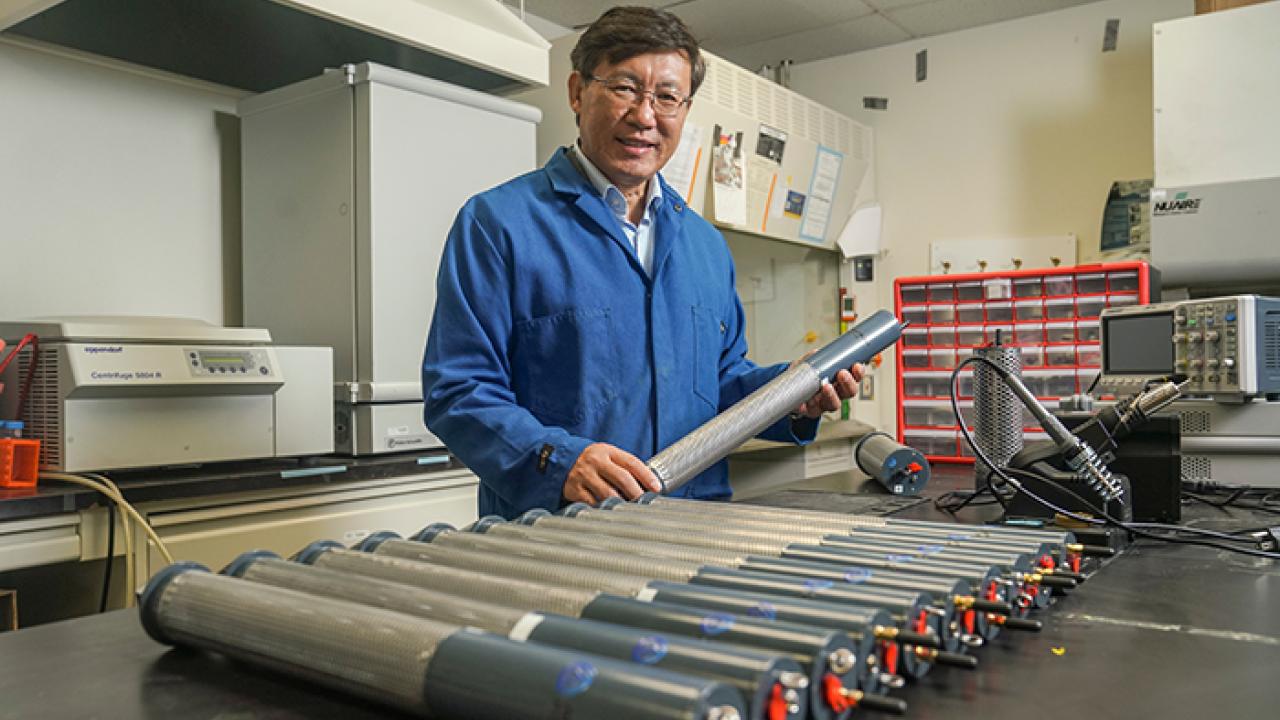
New Smart Technology Developed by UC Davis Professor May Help in Early Detection of Insects in Food and Agricultural Products
Post-harvest losses are common in the global food and agricultural industry. Research shows that storage grain pests can cause serious post-harvest losses, almost 9% in developed countries to 20% or more in developing countries. To address this problem, Zhongli Pan, an adjunct professor in the Department of Biological and Agricultural Engineering, has developed a potential solution.
Pan’s recent project using an IoT (Internet of Things) based smart wireless technology to remotely detect early insect activity in storage, processing, handling and transportation may solve the insect infestation related challenges for the agricultural industry. The technology uses a novel device called SmartProbe –– designed by Pan and his team using wireless sensors and cameras –– and leverages cloud computing to monitor and predict insect occurrences. This could help control insect pest, reduce food loss and the fumigants used in agricultural products today. Ragab Gebreil, a project scientist in Pan’s lab, is the co-inventor of this technology.
How the IoT based Technology Works
Five years ago, when the California Farmers’ Rice Cooperative reached out to him with an insect problem in rice storage, Pan decided to investigate.
The current inspection method involves manual detection of insects in the storage facilities by sending humans to the silos, which can be inaccurate, time consuming and incur high costs. Pan said that this kind of inspection may not even be possible for packaged products.
The new SmartProbe device that Pan and colleagues developed has three main functions: 1) to capture and photograph insects, 2) to measure the temperature and humidity of the environment using the integrated sensors, and 3) to send the images and sensor data to cloud servers using Wi-Fi. The servers then count the number of insects by analyzing the images. Notifications are then sent out to a PestDetect app, which the facility managers can use to take necessary pest control action.

“Through years of research, we found that the powerful technology we developed helps detect insects in the emerging phase before the damage is done,” said Pan. “Typically, the insects start from the top of stored or packaged product and move gradually to the bottom. With this new technology we can do the surface treatment by using only a small amount (e.g. 26%) of the chemicals instead of fumigating the entire product, which is not desirable.” Pan said that this 80% reduction in chemicals compared to traditional measures of fumigation is a significant development.
According to Pan, there are many benefits of using this SmartProbe device. The early detection and notification of insect infestation will solve common problems in pest management, such as product and quality loss, inappropriate amount of chemical use, food safety and workers’ safety concerns and high management costs.
Collaborations and Technology Support
With the support of California Rice Research Board and the Almond Board of California Pan and colleagues selected some of the storage facilities to work on the project. Pan also found that insect infestation caused significant damage to almonds in a very short time.
Pan stated that the team has successfully designed, built and demonstrated the online monitoring and early detection technology for insect activity in stored rice, almonds and walnuts at 13 commercial storage and processing facilities.
In 2022, Pan received support to advance the technology towards commercialization from the UC Davis Venture Catalyst Science Translation and Innovative Research (STAIRTM) grant program. The grant laid the foundation for Pan to form the startup AIVision Food Inc. during the 2021-22 fiscal year.
“The STAIR grant was very helpful in bringing the technology from the lab to the marketplace and has been the greatest support to transition from concept to commercialization,” said Pan.
Pan is optimistic about the role of AI in pest control for the agricultural industry. “Right now, AI is only helping detect what’s happening. When we have more of these kinds of smart devices, we’ll collect a lot of the data and then eventually the AI can use the data and models to predict where and when insect may occur, affording the opportunity to take action to prevent before the infestation starts,” he said. “The technology will be important to sustainable food production, and will reduce food loss and hunger in the world.”
Media Resources
AJ Cheline, UC Davis Office of Research, acheline@ucdavis.edu